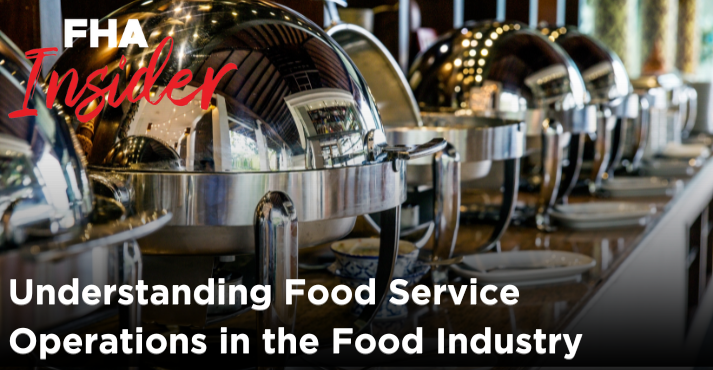
What is a food service operation? It’s the backbone of the food industry. Whether it’s a bustling restaurant, a cozy cafe, or a fast-food joint, the efficiency of food service operations plays a vital role in ensuring customer satisfaction and business success.
Food service operation refers to the process of preparing, serving, and managing food and beverages for customers. It involves everything from kitchen management, menu planning, staff coordination, customer interactions, and feedback handling.
In the competitive food industry, efficiency is the key to staying ahead. Well-organized food service operations ensure that orders are taken promptly and meals are served timely, delighting customers.
Quick and friendly service enhances customer satisfaction and encourages repeat visits, fostering customer loyalty.
Efficient food service operation goes hand-in-hand with customer satisfaction. Imagine a scenario where customers have to wait endlessly for their meals or receive incorrect orders. It leads to frustration and dissatisfaction.
However, with streamlined operations, such mishaps are minimized, and customers leave with smiles on their faces.
The success of any food establishment hinges on its ability to run smooth operations. Happy customers spread positive word-of-mouth, attracting more patrons.
Moreover, effective operations result in optimized resource utilization, reducing waste and costs, thereby improving the bottom line.
A smooth and efficient food service operation can make all the difference, from boosting customer satisfaction to ensuring long-term success.
So, whether you’re a restaurant owner or a budding entrepreneur, prioritize the art of managing your food service operation to thrive in the competitive food industry.
Types of Food Service

There are many different ways food is served to customers. These various methods are known as types of food service operations.
From fancy restaurants to quick and easy fast-food places, each type offers a different experience. Knowing about these types is essential for restaurant owners, managers, and customers, as it helps them find the right fit for their preferences.
Let’s explore the different food service operations that cater to the diverse tastes of people everywhere.
1. Full-Service Restaurants
Full-service restaurants are prime examples of food service operations that offer a complete dining experience.
When customers step in, the waitstaff welcomes them, guiding them to their tables. The waitstaff plays a crucial role in taking orders, recommending dishes, and ensuring guests have an enjoyable time.
Behind the scenes, the kitchen staff works diligently to prepare mouthwatering meals, paying attention to taste and presentation. They collaborate with the waitstaff to deliver meals promptly and cater to special requests.
Management plays a vital role in managing the entire operation, ensuring smooth customer interactions, and maintaining the restaurant’s overall ambiance and quality.
These key players work together to deliver exceptional dining experiences, leaving customers satisfied and eager to return for more.
The perfect blend of table service, delicious dishes, and attentive customer interactions in full-service restaurants leads to customer satisfaction that keeps patrons returning for a delightful experience.
2. Quick-Service Restaurants (Fast Food)
Quick-service restaurants, commonly known as fast-food joints, exemplify the fundamentals of food service operations. These eateries thrive on efficiency and speed, catering to customers on the go.
At a quick-service restaurant, the operation revolves around a fast-paced environment. Customers place their orders at the order counter or opt for the convenience of the drive-thru service. The streamlined process ensures swift delivery of their favorite fast-food items.
Behind the scenes, the kitchen staff works tirelessly to prepare standardized dishes, maintaining consistency in taste and quality. The emphasis is on speedy service without compromising on taste.
The success of a quick-service restaurant lies in its ability to serve a large number of customers swiftly and maintain their satisfaction.
By prioritizing speed and efficiency, these food service operations have mastered the art of delivering delicious meals in a flash, catering to the ever-growing demands of busy diners.
3. Cafes and Coffee Shops
Cafes and coffee shops offer a distinct type of food service operation centered around creating a warm and inviting atmosphere. These cozy establishments are beloved for their specialty coffee and delightful light meal offerings.
Barista service takes center stage at the heart of cafes and coffee shops. Highly skilled baristas expertly brew specialty coffee, transforming a simple cup of joe into a delightful experience.
The ambiance plays a vital role in attracting customers, who seek a serene space to enjoy their favorite beverages. Beyond coffee, these establishments often provide light meal options such as pastries, sandwiches, and snacks.
The combination of a cozy setting, specialty coffee, and delightful bites creates a haven for coffee enthusiasts and casual diners alike, making cafes and coffee shops a unique and cherished type of food service operation.
Food Safety and Sanitation

In the world of food service operations, ensuring food safety and sanitation is of paramount importance. Proper food handling, storage, and preparation are essential to prevent foodborne illnesses and maintain the well-being of customers.
Kitchen hygiene solutions play a crucial role in maintaining a clean and safe environment, reducing the risk of contamination, and ensuring the highest standards of food safety.
We will now explore the critical aspects of food safety and sanitation practices that every food service establishment must prioritize to safeguard the health and satisfaction of their patrons.
1. Food Handling Procedures
Ensuring food safety in both commercial and non-commercial food service is critical to preventing foodborne illnesses and maintaining customer well-being. Follow these essential food-handling practices:
- Maintain stringent hygiene standards: By washing hands and sanitizing surfaces and utensils on a regular basis.
- Preventing Cross-Contamination: Separate raw and cooked foods to avoid cross-contamination. For each, use separate cutting boards and equipment.
- Food Safety Preparation: Properly cook meats to appropriate temperatures to eradicate dangerous microorganisms.
- Proper Storage: Keep ingredients at room temperature to maintain freshness and avoid bacterial development.
By adhering to these food handling procedures, food service establishments can prioritize customer safety and deliver exceptional dining experiences and impeccable food service operations while mitigating the risk of foodborne illnesses.
2. Sanitation and Cleanliness
Maintaining impeccable sanitation and cleanliness is a cornerstone for success in the fundamentals of food service operations.
Beyond creating a pleasant dining experience, a clean and sanitary environment is essential to comply with health regulations and earn customer trust. Prioritize the following aspects of sanitation and cleanliness:
- Kitchen Hygiene: Regularly clean and sanitize kitchen surfaces, equipment, and utensils to prevent the accumulation of harmful pathogens.
- Dining Area Clean-up: Ensure regular clean-up and sanitization of tables, chairs, and other customer touchpoints to foster a positive impression.
- Health Inspection Compliance: Meeting health regulation standards is a legal requirement and reflects a commitment to customer welfare.
Compliance with health inspections showcases the dedication of food service establishments to providing safe and hygienic dining experiences, strengthening customer trust and loyalty.
Front-of-House and Back-of-House Operations

Front-of-House and Back-of-House Operations are the two essential pillars of any food service establishment. While Front-of-House handles customer interactions, reservations, and overall experience, Back-of-House ensures smooth kitchen operations, food preparation, and inventory management.
1. Front-of-House Responsibilities
Front-of-House staff plays a crucial role in the seamless operation of food service establishments. Their responsibilities encompass various guest interactions and ensuring top-notch customer service.
Greeting guests with a warm smile and friendly demeanor sets the tone for a positive dining experience. Taking orders accurately and efficiently ensures that customers’ preferences are met.
Front-of-House staff also manages reservations, seating arrangements, and handling customer inquiries. Their attentive service ensures that patrons feel welcome and attended to throughout their visit.
Guest satisfaction is paramount, and the Front-of-House team strives to create memorable moments for diners.
By managing front-of-house operations with precision and providing excellent customer service, food service establishments can build a loyal clientele and solidify their reputation in the competitive world of food service operations.
2. Back-of-House Responsibilities
Behind the scenes in food service operations, the Back-of-House staff ensures the efficient functioning of the kitchen, focusing on food preparation, cooking, and quality control. The skilled team, led by the chef, works diligently to bring culinary creations to life.
Back-of-House staff, including cooks and chefs, meticulously follow recipes and food safety protocols during food preparation. They work together to ensure dishes are perfectly cooked, maintaining food quality and taste.
Quality assurance is also vital, with rigorous checks to guarantee that each dish meets the establishment’s standards.
The Back-of-House staff’s commitment to excellence ensures that patrons are served excellent meals, making dining experiences truly memorable.
Menu Planning and Cost Control

An effective and well-thought-out menu plays a pivotal role in the success of any food service operation.
Menu planning involves careful consideration of dishes, pricing, and ingredient sourcing to meet customer expectations while maintaining profitability.
Equally important is cost control, which ensures that the business operates within budgetary constraints.
Striking the right balance between a diverse and appealing menu and prudent cost management is the key to maximizing profits and delighting customers in the competitive world of food service operations.
1. Menu Development
Menu planning is a strategic process that plays a vital role in both commercial and non-commercial food service operations. The key steps in menu development include the following:
- Designing a Well-Balanced Menu: Carefully selecting a variety of dishes to cater to diverse tastes and dietary preferences.
- Considering Customer Preferences: Understanding the target audience’s preferences to include popular and in-demand dishes.
- Menu Engineering: Analyzing the profitability and popularity of each dish to optimize revenue and customer appeal.
- Incorporating Dish Variety: Offering a wide range of appetizers, main courses, desserts, and beverages to create a comprehensive dining experience.
- Seasonal and Local Ingredients: Utilizing fresh and local ingredients to add uniqueness and appeal to the menu.
A well-planned menu enhances the dining experience, delights customers, and contributes to the success of food service operations in the culinary landscape.
2. Cost Control and Inventory Management
Effective cost control and efficient inventory management are crucial for maintaining profitability in the fundamentals of food service operations. The key elements include:
- Cost Control Measures: Implementing food cost analysis to identify areas for cost reduction and profit maximization.
- Prudent Stock Management: Carefully monitoring inventory levels and replenishing stock as needed to avoid excess and waste.
- Minimizing Food Waste: Reducing food waste through smart inventory practices and portion control.
- Optimizing Resource Utilization: Ensuring resources are utilized efficiently to minimize unnecessary expenses.
By employing these strategies, food service establishments can strike the right balance between financial stability and delivering exceptional dining experiences, paving the way for long-term success.
Staff Training and Customer Experience

In the exciting world of food service operations, staff training plays a significant role in creating happy customers.
When the team is well-trained and motivated, they can give excellent service, making dining experiences memorable. Proper training helps employees learn the right skills to satisfy customers.
With friendly and helpful staff, every visit becomes enjoyable. Let’s explore why staff training is essential for delivering fantastic customer experiences in the food service industry.
1. Employee Training Programs
Employees may improve their abilities in a variety of areas, including communication and problem-solving, as well as time management and teamwork, through well-designed training programs.
Food service organizations may dramatically enhance overall operations by investing in practical employee training.
Well-trained employees are better ready to manage a variety of scenarios, resulting in smoother workflows and fewer mistakes. As a result, a healthy work culture develops, which leads to pleased customers who feel valued and appreciated.
In a highly competitive industry, any food service establishment’s success is dependent on providing exceptional dining experiences. Employee training programs are critical to attaining this aim, producing a win-win situation for both employees and consumers.
2. Customer Experience Enhancement
In food service operations, delivering excellent customer experiences is at the heart of success. Understanding and exceeding customer needs are crucial in creating positive dining moments. Actively seeking guest feedback provides valuable insights for continuous improvement.
Food service establishments can build strong relationships with their patrons by prioritizing customer satisfaction and fostering positive guest interactions.
Gathering feedback on service, food quality, and overall experience enables them to make necessary adjustments and tailor offerings to meet customer expectations.
Enhancing customer experience results in happy and loyal customers and elevates the reputation of food service operations.
By consistently providing exceptional experiences, these establishments can set themselves apart in a competitive industry and thrive in the world of food service operations.
Technology Integration

Embracing cutting-edge technology has revolutionized the food service industry. From online ordering to advanced POS systems, technology enriches the dining experience and streamlines operations for greater efficiency.
1. Point-of-Sale (POS) Systems
Modern food service operations benefit greatly from integrating advanced Point-of-Sale (POS) systems.
These systems streamline order processing, enabling quick and accurate transactions. With digital payment solutions, customers experience convenience and flexibility while businesses can efficiently manage payments.
Furthermore, POS systems offer inventory tracking, ensuring better control over stock levels and reducing waste. By utilizing POS systems, food service operations enhance efficiency, improve customer experience, and optimize overall performance.
2. Online Ordering and Delivery
In food service operations, incorporating online ordering platforms and delivery services has become instrumental in expanding the customer base and increasing revenue.
Food delivery apps and online platforms offer convenience and accessibility, attracting a broader audience and capturing new markets.
Embracing these digital channels opens up opportunities to reach customers beyond the traditional brick-and-mortar setup.
By providing seamless online ordering and efficient delivery services, all types of food service operations can tap into the potential of the digital era, driving growth and enhancing their market presence.
Sustainability in Food Service

Embracing eco-friendly practices, the food service industry prioritizes sustainability. Responsible ingredient sourcing, reduced food waste, and energy-efficient operations are transforming the way establishments operate.
Sustainability appeals to environmentally-conscious consumers, benefitting both the planet and the industry.
Sustainable Sourcing and Practices
The fundamentals in food service operations and promoting sustainability have become a pivotal focus. Embracing eco-friendly practices, establishments are reevaluating their sourcing methods to prioritize locally sourced and sustainable ingredients.
Supporting local farmers and producers reduces their carbon footprint and contributes to the community.
Incorporating green initiatives, such as energy-efficient appliances and waste reduction programs, significantly impacts environmental conservation. Foodservice operators actively seek ways to minimize food waste through proper portioning or donating surplus food to those in need.
By embracing eco-friendly practices and sustainable sourcing, food service operations can make a positive contribution to the environment while aligning with the preferences of conscious consumers.
Sustainability is no longer just an option—it is the way forward for the responsible growth of the food service industry.
Conclusion
In this basic guide to the food service operation, we explored the essential elements that lead to a thriving food service business.
Efficiency emerged as a critical aspect, with simplified processes assuring on-time service and optimal resource usage. A customer-centric strategy is stressed, recognizing the importance of satisfied customers in generating loyalty and positive word-of-mouth.
Furthermore, sustainability was prioritized, with an emphasis on eco-friendly techniques, ethical sourcing, and waste minimization. Prioritizing sustainability helps the environment and resonates with conscientious consumers, improving the establishment’s reputation.
Finally, any food service organization’s success depends on the combination of efficiency, customer happiness, and sustainability.
With each aspect complementing the other, they pave the way for a successful and thriving food service business that positively impacts customers, communities, and the planet.










